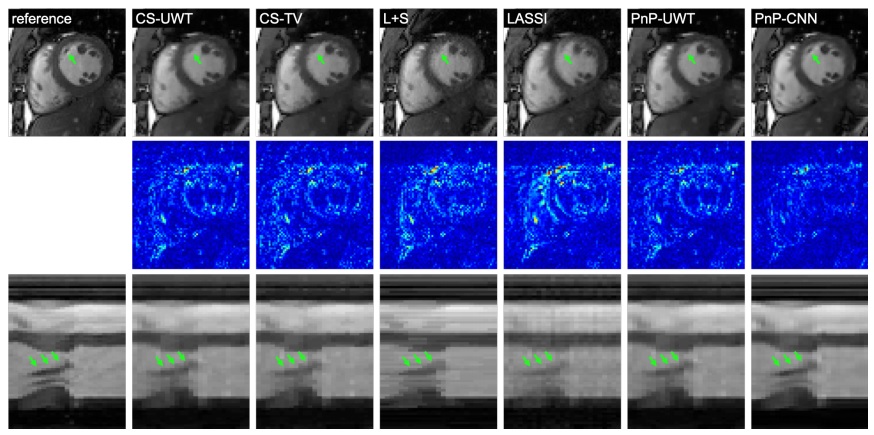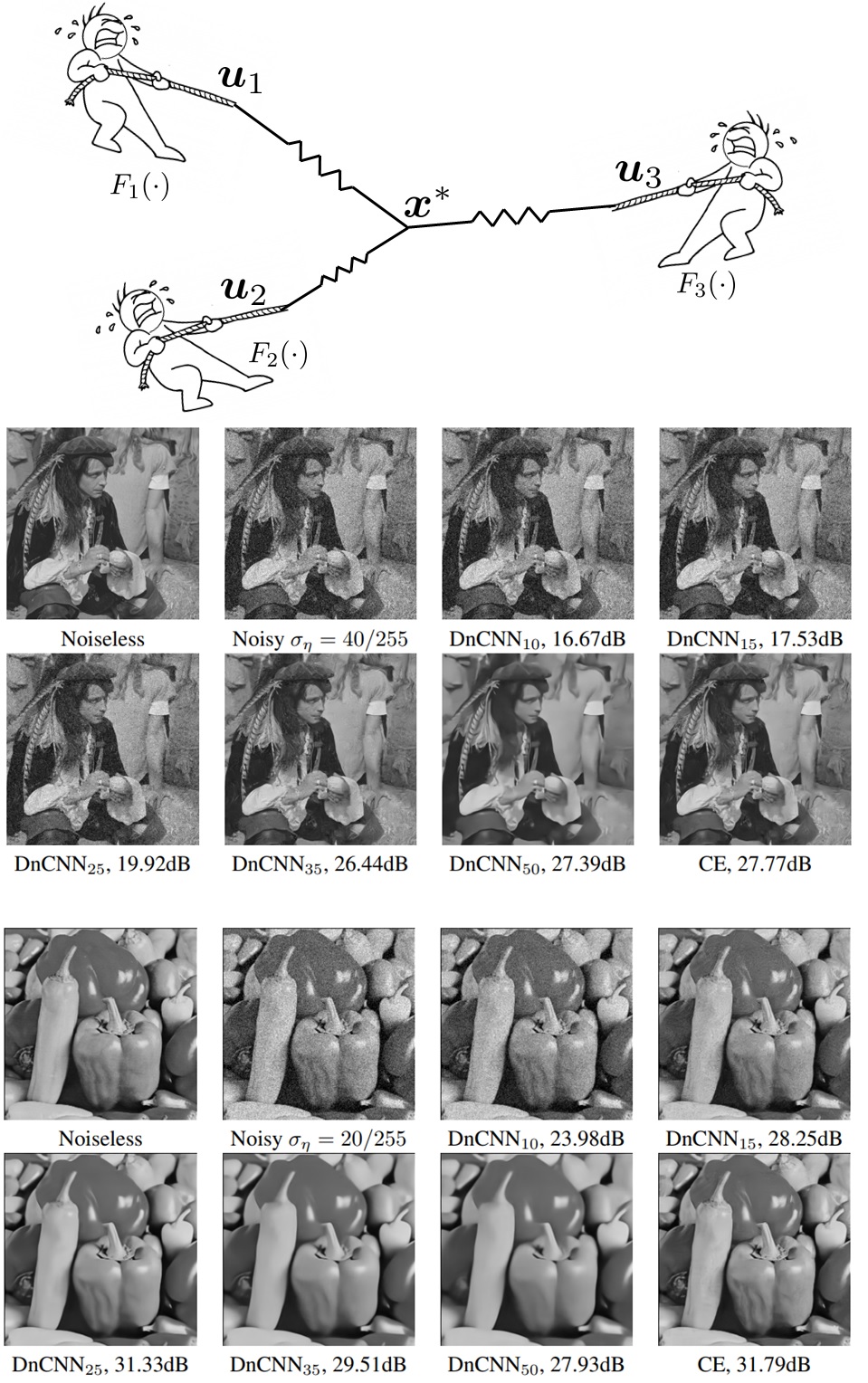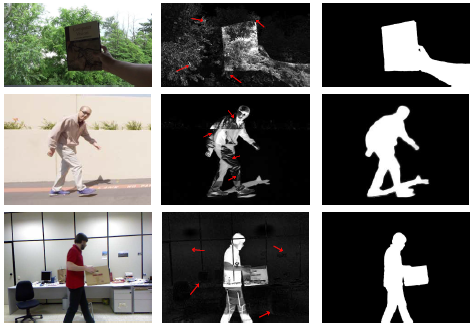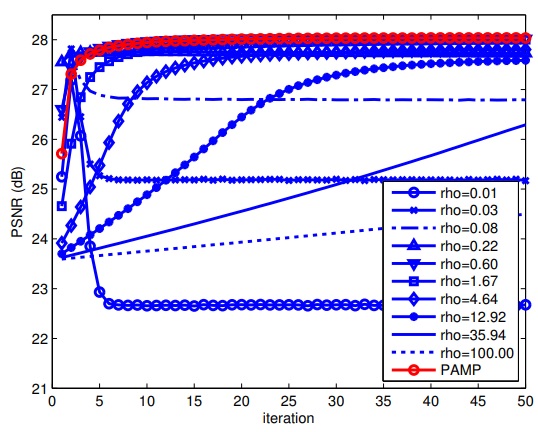Plug and Play ADMM
PnP Review (with applications to MRI)
 |
Magnetic Resonance Imaging (MRI) is a non-invasive diagnostic tool that
provides excellent soft-tissue contrast without the use of ionizing
radiation. Compared to other clinical imaging modalities (e.g., CT or
ultrasound), however, the data acquisition process for MRI is inherently
slow, which motivates undersampling and thus drives the need for accurate,
efficient reconstruction methods from undersampled datasets. In this article,
we describe the use of “plug-and-play” (PnP) algorithms for MRI image
recovery. We first describe the linearly approximated inverse problem
encountered in MRI. Then we review several PnP methods, where the unifying
commonality is to iteratively call a denoising subroutine as one step of a
larger optimization-inspired algorithm. Next, we describe how the result of
the PnP method can be interpreted as a solution to an equilibrium equation,
allowing convergence analysis from the equilibrium perspective. Finally, we
present illustrative examples of PnP methods applied to MRI image
recovery. Publication: Rizwan Ahmad, Charles A. Bouman, Gregery T. Buzzard, Stanley H. Chan, Edward T. Reehorst, Philip Schniter, ‘‘Plug-and-Play methods for magnetic resonance imaging’’, IEEE Signal Processing Magazine, 2019. |
Comparing PnP and RED
 |
The Plug-and-Play (PnP) ADMM algorithm is a powerful image restoration
framework that allows advanced image denoising priors to be integrated into
physical forward models to yield a provably convergent algorithm. However,
despite the enormous applications and promising results, very little is known
about why the PnP ADMM performs so well. This paper presents a formal
analysis of the performance of PnP ADMM. By restricting the denoisers to the
class of graph filters, or more specifically the symmetric smoothing filters,
we offer three contributions: (1) We rigorously show conditions under which
an equivalent maximum-a-posteriori (MAP) optimization exists, (2) we derive
the mean squared error of the PnP solution, and provide a simple geometric
interpretation which can explain the performance, (3) we introduce a new
analysis technique via the concept of consensus equilibrium, and provide
interpretations to general linear inverse problems and problems with multiple
priors. Publication: Stanley H. Chan, ‘‘Performance analysis of Plug-and-Play ADMM: A graph signal processing perspective’’, IEEE Trans. Comp. Imaging, vol. 5, no. 2, pp. 274-286, Jun. 2019. |
Generalizing PnP with Consensus Equilibrium
 |
Regularized inversion methods for image reconstruction are used widely due to
their tractability and ability to combine complex physical sensor models with
useful regularity criteria. Such methods motivated the recently developed
Plug-and-Play prior method, which provides a framework to use advanced
denoising algorithms as regularizers in inversion. However, the need to
formulate regularized inversion as the solution to an optimization problem
limits the possible regularity conditions and physical sensor models. In this
paper, we introduce Consensus Equilibrium (CE), which generalizes regularized
inversion to include a much wider variety of both forward components and
prior components without the need for either to be expressed with a cost
function. CE is based on the solution of a set of equilibrium equations that
balance data fit and regularity. In this framework, the problem of MAP
estimation in regularized inversion is replaced by the problem of solving
these equilibrium equations, which can be approached in multiple ways. The
key contribution of CE is to provide a novel framework for fusing multiple
heterogeneous models of physical sensors or models learned from data. We
describe the derivation of the CE equations and prove that the solution of
the CE equations generalizes the standard MAP estimate under appropriate
circumstances. We also discuss algorithms for solving the CE equations,
including ADMM with a novel form of preconditioning and Newton's method. We
give examples to illustrate consensus equilibrium and the convergence
properties of these algorithms and demonstrate this method on some toy
problems and on a denoising example in which we use an array of convolutional
neural network denoisers, none of which is tuned to match the noise level in
a noisy image but which in consensus can achieve a better result than any of
them individually. Publication: Gregery T. Buzzard, Stanley H. Chan, Suhas Sreehari and Charles A. Bouman
‘‘Plug-and-Play unplugged: Optimization
free reconstruction using consensus equilibrium’’, SIAM Journal on Imaging
Science, vol. 11, no. 3, pp.2001-2020, Sep. 2018. |
Application of Consensus Equilibrium
 |
While foreground extraction is fundamental to virtual reality systems and has
been studied for decades, majority of the professional softwares today still
rely substantially on human interventions, e.g., providing trimaps or
labeling key frames. This is not only time consuming, but is also sensitive
to human error. In this paper, we present a fully automatic foreground
extraction algorithm which does not require any trimap or scribble. Our
solution is based on a newly developed concept called the Multi-Agent
Consensus Equilibrium (MACE), a framework which allows us to integrate
multiple sources of expertise to produce an overall superior result. The MACE
framework consists of three agents: (1) A new dual layer closed-form matting
agent to estimate the foreground mask using the color image and a background
image; (2) A background probability estimator using color difference and
object segmentation; (3) A total variation minimization agent to control the
smoothness of the foreground masks. We show how these agents are constructed,
and how their interactions lead to better performance. We evaluate the
performance of the proposed algorithm by comparing to several
state-of-the-art methods. On the real datasets we tested, our results show
less error compared to the other methods. Publication:
|
PnP for Graphs
 |
Signals defined on a network or a graph are often prone to errors due to
missing data and noise. In order to restore the graph signal, interpolation
and denoising are two necessary steps along with other graph signal
processing procedures. However, existing graph signal interpolation and
denoising methods are largely decoupled due to the opposite objectives of the
two tasks and the inherent high computational complexity. The goal of this
paper is to integrate graph interpolation and denoising using the
Plug-and-Play (PnP) ADMM, a recently developed technique in image processing.
When using the subsampling process as the forward model and graph filter as
the denoiser, we show that PnP ADMM is equivalent to interpolating a
bandlimited signal. Preliminary results are demonstrated via experiments,
where the proposed method shows significantly better performance over
existing methods. Publication: Yoshinao Yazaki, Yuichi Tanaka, and Stanley H. Chan,
‘‘Interpolation and denoising
of graph signals using Plug-and-Play ADMM’’, IEEE ICASSP, pp. 5431-5435,
Brighton, United Kingdom, May 2019. |
Parameter-Free PnP
 |
Plug-and-Play ADMM is a recently developed variation of the classical ADMM
algorithm that replaces one of the subproblems using an off-the-shelf image
denoiser. Despite its apparently ad-hoc nature, Plug-and-Play ADMM produces
surprisingly good image recovery results. However, since in Plug-and-Play
ADMM the denoiser is treated as a black-box, behavior of the overall
algorithm is largely unknown. In particular, the internal parameter that
controls the rate of convergence of the algorithm has to be adjusted by the
user, and a bad choice of the parameter can lead to severe degradation of the
result. In this paper, we present a parameter-free Plug-and-Play ADMM where
internal parameters are updated as part of the optimization. Our algorithm is
derived from the generalized approximate message passing, with several
essential modifications. Experimentally, we find that the new algorithm
produces solutions along a reliable and fast converging path. Publication:
|
PnP Fixed Point Convergence
 |
We propose a Plug-and-Play ADMM algorithm with provable fixed point convergence. We show that for any
denoising algorithm satisfying an asymptotic criteria, called bounded denoisers, Plug-and-Play ADMM converges to
a fixed point under a continuation scheme. We also present fast implementations for two image restoration problems on
super-resolution and single-photon imaging. We compare Plug-and-Play ADMM with state-of-the-art algorithms in each
problem type, and demonstrate promising experimental results of the algorithm. Publication:
|